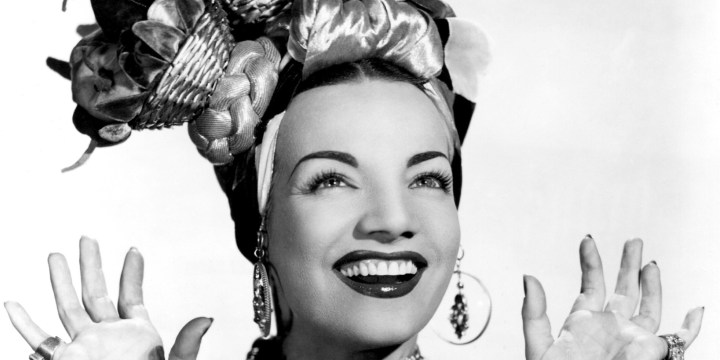Stereotype or Samba Pioneer? A Look Back at the Controversial Legacy of Carmen Miranda

Photo: Bruno of Hollywood via Getty Images
Over 60 years have passed since Carmen Miranda’s tragic, untimely death at the age of 46, but the so-called Brazilian Bombshell’s iconic image continues reverberating through our cultural memory to this day. From her expressive eyes and vibrant smile to her larger-than-life, tropical fruit-inspired outfits, Miranda’s legacy persists in everything from fashion and design to the instantly recognizable Chiquita Banana logo inspired by her image. But few are familiar with the long and winding road the brought the native of a small town in northern Portugal to the biggest stages and screens the world had to offer.
Born in 1909, Miranda first arrived in Brazil when she was only a year old, and though she never returned to the country of her birth, she retained her Portuguese nationality throughout her life. As a young woman Miranda began working in a boutique designing hats before ultimately recording her first album with composer Josue Barros in 1929. Yet it was her 1930 recording of the song (Taí, Eu fiz Tudo) Prá Você Gostar de Mim, written by Joubert de Carvalho, that catapulted her to national stardom and cemented her status as the premiere interpreter of the increasingly popular samba genre.
Throughout the 1930s, Miranda performed on Brazilian radio stations and appeared in a handful of early Brazilian sound films called Chanchadas, which celebrated Brazilian music, dance, and carnaval culture. Features like Alô, Alô, Brasil! and Alô, Alô, Carnaval embodied the spirit of these early Miranda films, though it was the 1939 musical Banana da Terra, directed by Ruy Costa, that brought the world her iconic “Baiana” image, inspired by the wardrobe of poor afro-descendents from the northeastern state of Bahia.
Later that year, Broadway producer Lee Shubert caught sight of Miranda’s stage show at one of Rio’s famous casinos and invited her to perform in the Broadway review The Streets of Paris later that year. After arriving in New York with some members of her backup band Bando da Lua, Miranda quickly became a Broadway sensation and earned glowing reviews from the US’s most important critics. Success on the stage quickly led to a movie contract with Twentieth Century-Fox and the birth of Carmen Miranda’s enduring Hollywood legend came in the form of the 1940 technicolor musical Down Argentine Way, directed by Lee Cummings.
Throughout this time, Miranda emerged as a symbol of strengthening diplomatic ties between the United States and Brazil, built as much around the US war effort and Franklin Roosevelt’s strategic “Good Neighbor policy” as Brazil’s desire for dominance in the North American coffee market. As part of these diplomatic overtures, Brazilian president Getúlio Vargas went so far as to pay the passage of Miranda’s band members on their initial voyage to New York, and soon after her arrival, Miranda was introduced to Roosevelt at a White House banquet.
Yet the “Latin American” roles Miranda pioneered in the wartime film industry generally had very little to do with the cultural specificities of Brazil, and usually amounted to a hodgepodge of stereotypical elements of Brazilian, Mexican, Cuban, and Argentine culture. This was epitomized in films like Down Argentine Way, which was ultimately banned from Argentina for its insulting and inauthentic portrayal of Argentina. Walter Lang’s 1931 musical Week-End in Havana similarly earned the ire of Cubans resentful that the film featured no authentic Cuban dances. To boot, Miranda’s “exotic” wardrobe became increasingly exaggerated and over-the-top with each film, culminating with director Busby Berkeley’s 1943 musical, The Gang’s All Here, in which Miranda’s fruit hat reached new, massive proportions.
Indeed, while her star rose ever higher in the United States, Miranda was increasingly derided in her home country for what critics perceived as her negative, overly Americanized image of Brazilian culture; and at the height of her fame she underwent a self-imposed exile of 14 years. But her dominance of American movie screens would also prove fleeting, and after making it to the mountaintop as Hollywood’s highest-paid entertainer in 1945, the shifting economic landscape of the postwar years led to changing tastes in the US movie industry.
By 1945’s Doll Face, Miranda had fallen back down to fourth billing, and the vibrancy of her technicolor years gave way to monochrome black-and-white film stock. Miranda took the opportunity to reinvent her image and show off some of her comedy chops alongside Groucho Marx in the independent 1947 musical comedy Copacabana, directed by Alfred E. Green, but the film was met with lukewarm reviews and dismal box office returns. With her film roles increasingly reduced to cameos with little dramatic import, Miranda focused increasingly on her musical career and continued drawing large crowds for her stage shows.
In October of 1955, after suffering through years of depression, substance abuse, and declining health, Miranda died of a heart attack only hours after taping a segment for NBC’s The Jimmy Durante Show. As per her wishes, Miranda’s body was returned to Brazil and her funeral procession through Rio de Janeiro drew hundreds of thousands of mourners. In the decades after her death, Miranda was held up by a new generation of artists as an ambivalent but beloved pioneer of Brazilian culture on the world stage and her legacy was summed up succinctly and powerfully by iconic Tropicalismo composer Caetano Veloso in an article for the New York Times:
“For generations of musicians who were adolescents in the second half of the 1950s and became adults at the height of the Brazilian military dictatorship and the international wave of counterculture-my generation-Carmen Miranda was first a cause of both pride and shame,” he wrote. “And later, a symbol that inspired the merciless gaze we began to cast upon ourselves, Carmen conquered ‘white’ America as no other South American has done or ever would.”